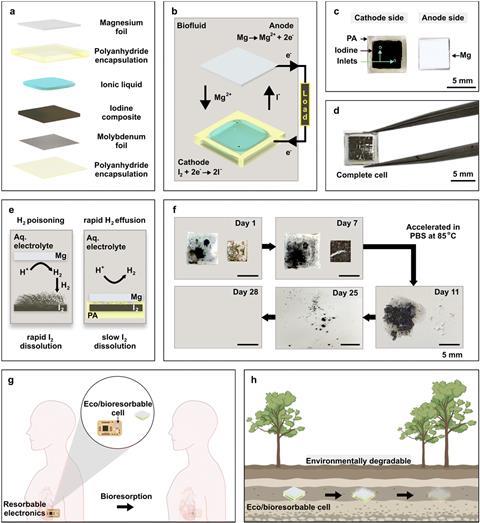Researchers in the US have constructed batteries that can be completely absorbed by the environment or living organisms after they have worked for a short amount of time. The batteries could be developed to power temporary cardiac pacemakers or for environmental monitoring.
Earlier work on similar technology had been limited by low voltage outputs or energy densities, restricting their usefulness to low-power systems like LEDs or simple calculators. ‘We noticed the operating voltage of almost all the reported batteries were less than one volt, and then the capacity was negligible … if you want to have something for real life applications, you really need to increase the output voltage, and the capacity of the cell,’ explains Amay Bandodkar at North Carolina State University who led the work alongside John Rogers of Northwestern University.
The team began with materials that were well characterised for biodegradability, settling on magnesium and iodine electrodes. They quickly found that containing all the components in one vessel like a traditional battery led to low performance. The magnesium became surrounded by hydrogen bubbles as it oxidised, and the iodine quickly polluted the system.
Instead, they developed a hybrid architecture separating the anode and cathode, and a dual electrolyte system. Keeping the magnesium anode outside the battery pouch, the ambient medium acts as an anolyte, interfacing slowly with the choline-based ionic fluid surrounding the iodine cathode. This viscous ionic fluid slows the iodine leaching while the hydrogen bubbles produced on the magnesium are free to disperse. ‘With this kind of a setup we were able to get a much higher capacity and the battery survived for almost a week without much degradation,’ says Bandodkar.
While the batteries lasted about a week when implanted in mouse models, they could last much longer in everyday applications, such as a TV remote. The shorter lifespan could be desirable for some medical devices, like a temporary pacemaker. These are sometimes implanted during open heart surgery and surgically removed a few days later – with a resorbable battery, it would just disappear.

Gustav Nyström, whose research involves developing advanced sustainable materials and biodegradable batteries at Empa in Switzerland, suggests controlling resorption could be an important future step. ‘It is an inherent challenge to be able to control device lifetime for the application; to be able to tune this with the materials, and maybe also to be able to activate degradation by external stimuli.’
Zhongfan Jia, whose research at Flinders University in Australia involves fabricating all-organic batteries, says: ‘For a long time, implantable batteries were just a concept, and we could see some conceptual images, but I hadn’t really seen the real thing happen.’
For Bandodkar, moving on from a single-use system is an intriguing prospect. ‘We were able to show this for primary cells … but can we also make them rechargeable? That would be even more exciting.’